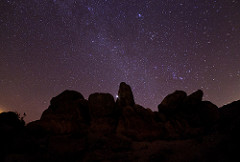Look – Up in the Sky!
By Mary Bigelow
Posted on 2018-06-10
Each month in NSTA’s Science Scope journal, Bob Riddle writes Scope on the Skies, an informational article on topics related to astronomy. Bob i s a science educator in Lee’s Summit, Missouri, and also authors the website Bob’s Spaces in which he frequently posts additional articles, updates, and resources. You can also read more about his background and experiences on this website.
s a science educator in Lee’s Summit, Missouri, and also authors the website Bob’s Spaces in which he frequently posts additional articles, updates, and resources. You can also read more about his background and experiences on this website.
The Scope on the Skies “background boosters” present content information in an easy-to-read format with many illustrations, resources, and applications for the classroom. The articles also include a monthly calendar of astronomical events.
Although this is published in NSTA’s middle school journal, teachers of other grade levels can access and read these articles in Science Scope as NSTA members. These articles could also be shared with secondary students as a supplement to other readings and as an example of how to communicate science concepts in terms that everyone can understand.
Here are the Scope on the Skies articles that appeared within the last two years:
- Timely Motions of the Earth and Moon
- Storms From the Skies
- Gaining Insight Into Mars
- Motions of the Earth and Beyond
- Studying Rings Around the Sun
- The Historic Stars in Our Skies
- Connected Computing
- Angles and Eclipses
- Juno’s Route to Jupiter
- In Transit
- GRACE, GRAIL, and Gravity
- A Leap Forward
- A Model Solar System
- Star Chart
- Measuring the Universe
- A Candle in Space
- Cassini’s Grand Finale
- Vocabulary of the Skies
- The Universe, From Micro to Macro
- Beyond Earth’s Orbit
- In the Midst of an Eclipse Season
- Flipped Constellations
For more information and activities on astronomy-related topics, see these SciLinks—
K-4: Astronomy, Comets Asteroids Meteors, Extrasolar Planets, Moon Phases, Planets, Sun
5-8: Astronomy, Big Bang, Comets, Constellations, Early Astronomers, Early Theories in Astronomy, Galaxies, Inner Planets, Lunar Cycle, Milky Way, Moons of Other Planets, Outer Planets, Phases of the Moon, Structure of the Universe, What Is the Life Cycle of a Star?
9-12: Astrobiology, Astronomy, Astrophysicist, Big Bang, Black Holes, Comets Asteroids Meteors, Constellations, Early Astronomers, Galaxies, Inner Planets, Meteoroids, Milky Way Galaxy, Moons of Other Planets, Origin of the Solar System, Outer Planets, Radioastronomy, What Is a Star?
Graphic: https://tinyurl.com/y9vq3mvp
Disclaimer: The views expressed in this blog post are those of the author(s) and do not necessarily reflect the official position of the National Science Teaching Association (NSTA).


